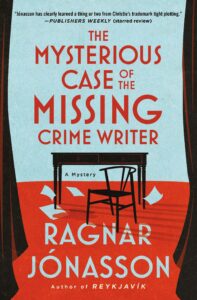 This is the kind of terrific book that gets you to the middle and you aren’t sure what’s coming next. It’s the follow up to the excellent Death at the Sanatorium, though it’s billed as a standalone. In fact, it picks up right where Death at the Sanitorium left off, resolving the question of what happened to the main character, Helgi. In the last book, Helgi was working on a master’s thesis based on an old crime; in this novel, he’s no longer a student, but a member of the Icelandic police force.
This is the kind of terrific book that gets you to the middle and you aren’t sure what’s coming next. It’s the follow up to the excellent Death at the Sanatorium, though it’s billed as a standalone. In fact, it picks up right where Death at the Sanitorium left off, resolving the question of what happened to the main character, Helgi. In the last book, Helgi was working on a master’s thesis based on an old crime; in this novel, he’s no longer a student, but a member of the Icelandic police force.
As in the last book, Helgi is a fan of classic crime novels, and always has one to hand, even having a shelf of them in his office at the police station. Probably because of this, Helgi is given a big case: find missing crime writer Elín S. Jónsdóttir. She’s one of Iceland’s most famous writers, notoriously retired after ten bestsellers. Interspersed through the complex narrative is an interview between Elin and an unknown journalist, allowing the reader to get to know and understand her better.
Jónasson writes very complex books, but they are pleasant reads that aren’t confusing. It’s a deft trick to manage so many timelines and not leave the reader wanting to throw the book across the room. In one, it’s the present – it’s 2012 and Helgi is investigating the case of the missing writer. In the past it’s 1965, where a crime is being planned; in another, it’s the late 60’s where Helgi’s former supervisor Hulda is interviewing a bank robber in prison, trying to get him to name his accomplice; and the journalist’s interview with Elin takes place in 2005.
In the course of his search, Helgi interviews all of her friends and her one cousin (and only family member), fleshing out her character. One of her best friends is her editor and her husband; all of them were in school together. They are now in their 70s.
Helgi’s personal life is not so great, however. In the last book, he had an abusive, alcoholic girlfriend. They are now broken up and he has a new girlfriend, but the old girlfriend is stalking the new one. The personal part is important (as well as suspenseful and scary) because it illustrates Helgi’s personality. He sets aside things he doesn’t want to deal with until “tomorrow,” and his horrible ex girlfriend falls into that category.
This is an intelligently plotted mystery, filled with excellently drawn characters and full of the kind of twists that come organically from the plot. Only a very gifted writer is able to do this. The part with the girlfriend, however, hangs over the story and it almost seems like it’s from a different novel than the one with the tricky and interesting mystery. I don’t mind the personal life of a character, but I feel the domestic part of the character’s life should sync with the professional part. And the ending (like the ending in the first book) was completely jarring. I want to know what happens, now! But I know I have to wait a year, making this a qualified recommendation. The mystery part is great; Helgi’s life, not so much. As it’s a small part of the novel you may feel, as I did, that the rest of the book was worth the read. — Robin Agnew